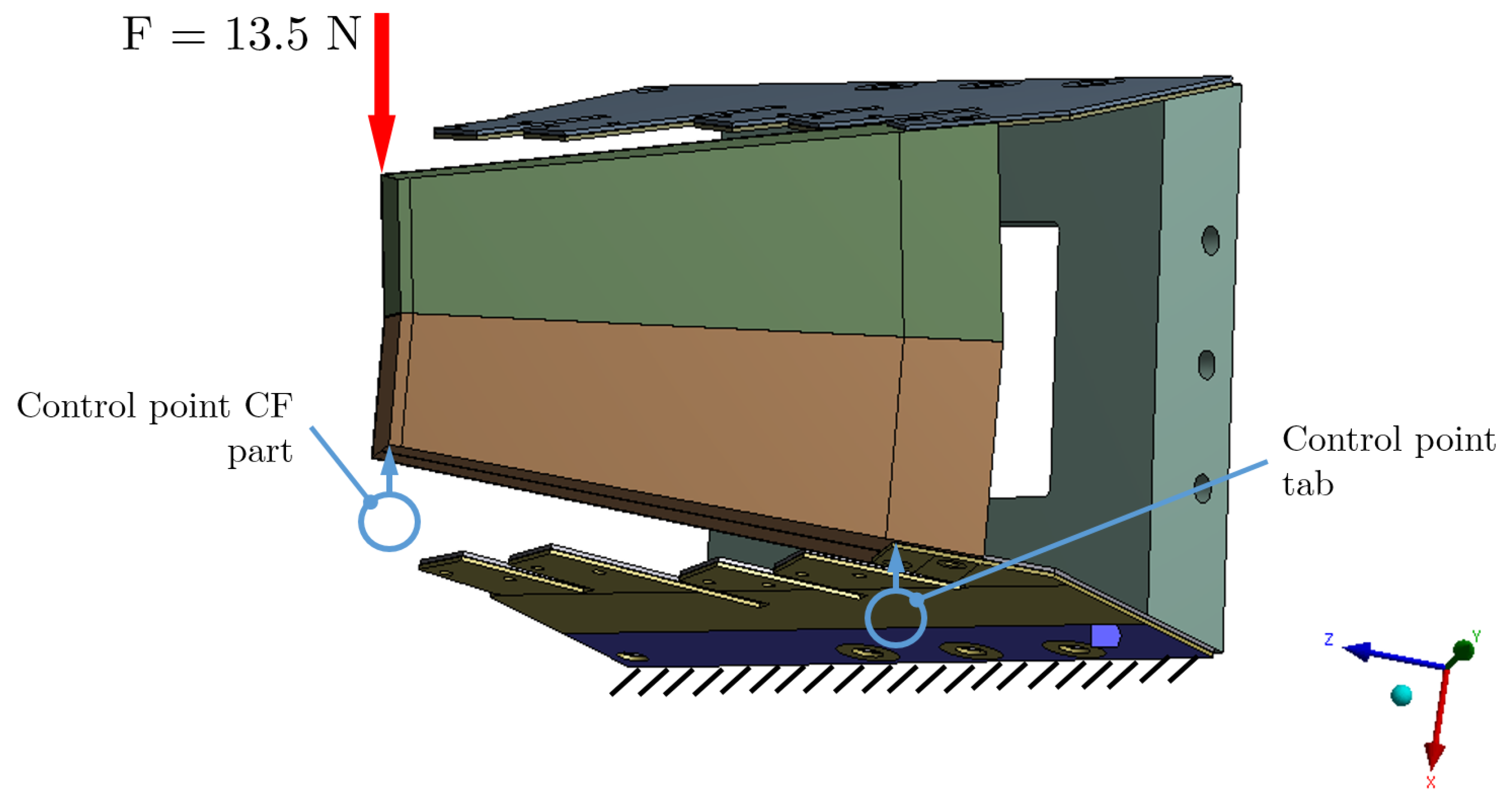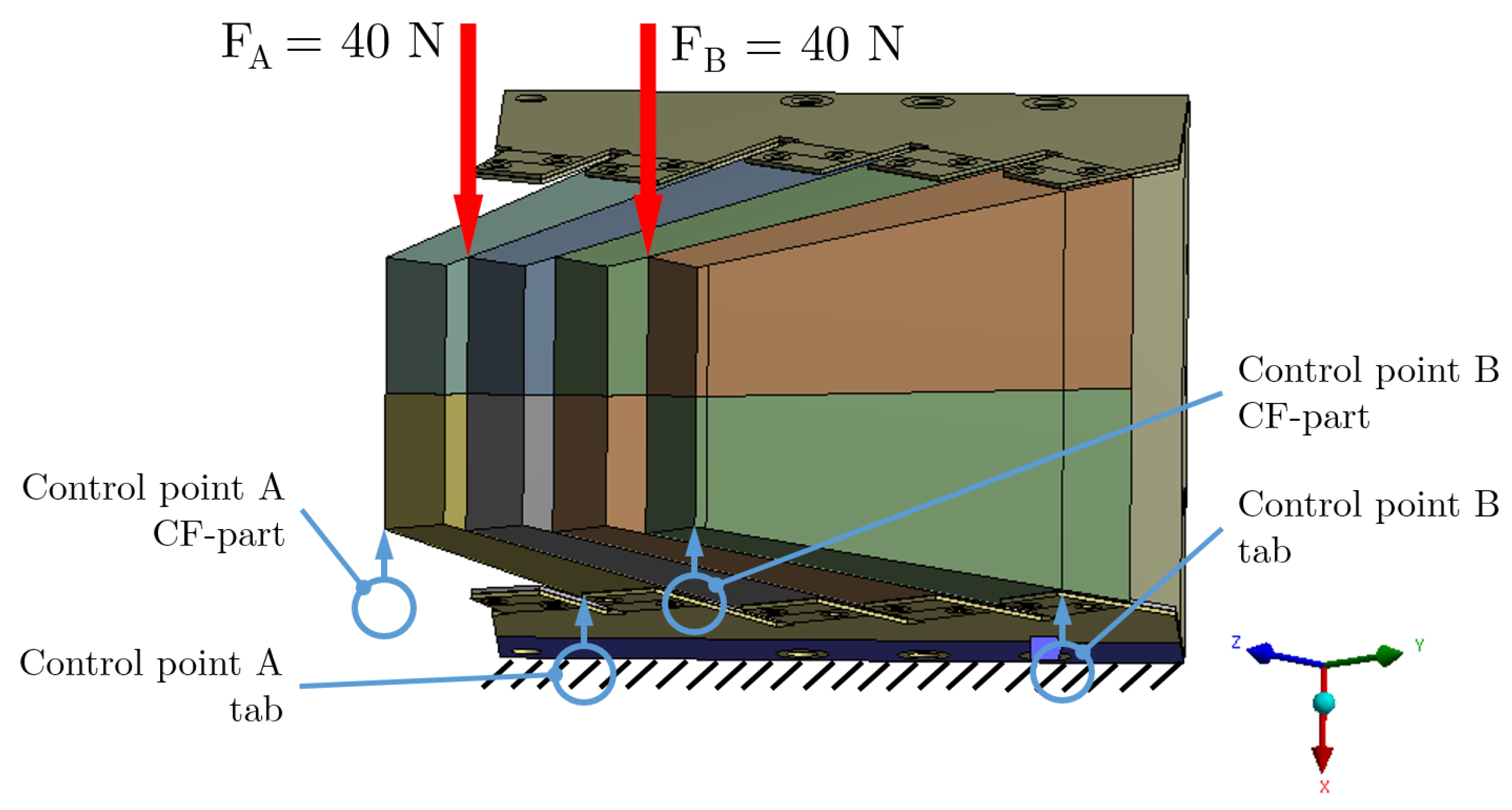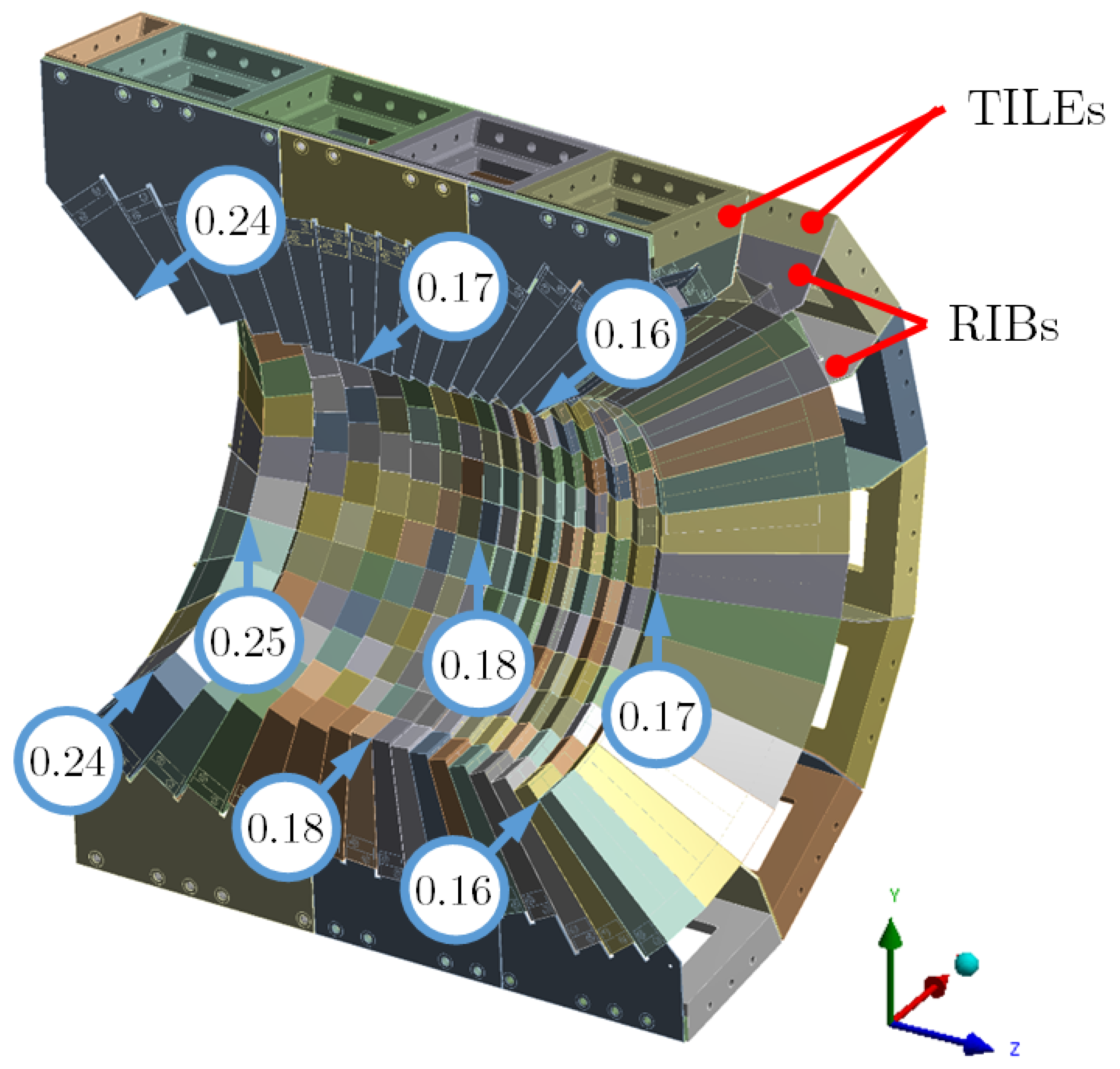Evaluation of an FE Model for the Design of a Complex Thin-Wall CFRP Structure for a Scientific Instrument
Abstract
:1. Introduction
2. The CALIFA-FAIR Calorimeter: A Case Reference
Construction of the CALIFA Calorimeter
3. Mechanical Tests Setup and Measurements to Obtain the Reference Data
3.1. Setup with Two CF-Parts
3.2. Setup with Eight CF-Parts
4. Definition and Analysis of the FE Models
4.1. Material Properties
4.2. Mesh Model
4.3. Model Boundary Conditions: Loads, Support and Contacts
5. Results and Discussion for Mechanical Test Setups and FE Models
5.1. Models with Two CF-Parts
5.1.1. FE Model-1: CFRP Pre-Processing and Nonlinear Contacts
5.1.2. FE Model-2: CFRP* Isotropic Material and Nonlinear Contacts
5.1.3. FE Model-3: CFRP* Isotropic Material and Linear Contacts
5.1.4. FE Model-4: CFRP* Isotropic Material and Realistic Loads
5.2. Model with Eight CF-Parts
6. FE Model for the Instrument Structure
6.1. Model Deformations
6.2. Model Reliability
6.3. Modelling and Computing Time
7. Conclusions
- The overall time necessary for the model definition and calculation fits in a reasonable time span to interact with the project needs, despite the large amount of parts and contacts defined in the FE model.
- The total deformation calculated provided values below 0.24 mm in the key regions. The overall uncertainty expected from small setups to the whole structure was estimated and a sound maximal deformation was set (0.9 mm). For comparison, the production and mounting tolerance values remain much higher (220% factor). Therefore, the FE model can definitely provide useful results for the design project.
Author Contributions
Funding
Acknowledgments
Conflicts of Interest
Abbreviations
| FE | finite element |
| CFRP | carbon-fibre reinforced plastic |
| CF | carbon fiber |
| CFRP* | (virtual) isotropic material |
| FKT | bonded contact stiffness factor, tangential component |
| FKN | bonded contact stiffness factor, normal component |
| RIB-TILE | contact region of the rib and tile parts |
| RIB-RIB | contact region of two rib parts |
| RIB-CFRP | contact region of the rib and CFRP parts |
| CFRP-BLOCK | contact region of the CFRP and block parts |
| CFRP-CFRP | contact region of two CFRP parts |
References
- Kassapoglou, K. Design and Analysis of Composite Structures, 2nd ed.; Wiley & Sons: London, UK, 2013; ISBN 978-1-118-40160-6. [Google Scholar]
- Breuer, U.P. Commercial Aircraft Composite Technology; Springer: Cham, Switzerland, 2016; ISBN 978-3-319-31917-9. [Google Scholar]
- Walker, M. Optimal Design of Fibre-reinforced Laminated Plates Accounting for Manufacturing Uncertainty. Int. J. Mech. Mater. Des. 2005, 2, 147–155. [Google Scholar] [CrossRef]
- Yin, H.; Wen, G. Theoretical prediction and numerical simulation of honeycomb structures with various cell specifications under axial loading. Int. J. Mech. Mater. Des. 2011, 7, 253–263. [Google Scholar] [CrossRef]
- El-Abbasi, N.; Meguid, S.A. A Continuum Based Thick Shell Element for Large Deformation Analysis of Layered Composites. Int. J. Mech. Mater. Des. 2005, 2, 99–115. [Google Scholar] [CrossRef]
- Jessen, N.C.; Norgaard-Nielsen, H.U.; Schroll, J. CFRP lightweight structures for extremely large telescopes. Compos. Struct. 2008, 82, 310–316. [Google Scholar] [CrossRef]
- Hick, M.T. Design of a Carbon Fiber Composite Grid Structure for the GLAST Spacecraft; SLAC Report 575; Stanford University: Stanford, CA, USA, 2001. [Google Scholar]
- Morozov, E.V.; Lopatin, A.V. Analysis and design of the flexible composite membrane stretched on the spacecraft solar array frame. Compos. Struct. 2012, 94, 3106–3114. [Google Scholar] [CrossRef]
- Olcesea, M.; Caso, C.; Castiglioni, G.; Cereseto, R.; Cuneo, S.; Dameri, M.; Claudia, G.; Glitza, K.-W.; Lenzen, G.; Mora, M.; et al. Ultra-light and stable composite structure to support and cool the ATLAS pixel detector barrel electronics modules. Nucl. Instrum. Meth. A 2004, 518, 728–737. [Google Scholar] [CrossRef]
- Giraudo, G.; Borotto, F.; van den Brink, A.; Buskop, J.; Coli, S.; Feofilov, G.; Igolkine, S.; Nooren, G.J.L.; Riccati, L. The SDD and SSD support structure for the ALICE Inner Tracking System. J. Instrum. 2009, 4, P01003. [Google Scholar] [CrossRef]
- Wieman, H.H.; Anderssen, E.; Greiner, L.; Matis, H.S.; Ritter, H.G.; Sun, X.; Szelezniak, M. STAR PIXEL detector mechanical design. J. Instrum. 2009, 4, P05015. [Google Scholar] [CrossRef]
- de Lorenzis, L.; Grancagnolo, F.; L’Erario, A.; Maffezzoli, A.; Miccoli, A.; Rella, S.; Spedicato, M.; Zavarise, G. Analysis and characterization of the mechanical structure for the i-tracker of the mu2e experiment. Nucl. Phys. B 2014, 248–250, 134–136. [Google Scholar] [CrossRef]
- Aumann, T. Technical Report for the Design, Construction and Commissioning of The CALIFA Barrel. 2011. Available online: https://edms.cern.ch/document/1833500/1 (accessed on 4 February 2019).
- Casarejos, E.; Alvarez Pol, H.; Cortina-Gil, D.; Durán, I.; Izquierdo, P.; Yáñez Alfonso, P.; Vilan, J.A. The mechanical design of the BARREL section of the detector CALIFA for R3B-FAIR. EPJ Web Conf. 2014, 66, 11037. [Google Scholar] [CrossRef]
- Casarejos, E.; Alvarez Pol, H.; Cortina-Gil, D.; Durán, I.; Izquierdo, P.; Yáñez Alfonso, P.; Vilan, J.A. Design and construction of the structure of the DEMONSTRATOR of the CALIFA detector for R3B-FAIR using carbon-fiber composites. EPJ Web Conf. 2014, 66, 11038. [Google Scholar] [CrossRef]
- Meng, M.; Le, H.R.; Rizvi, M.J.; Grove, S.M. The effects of unequal compressive/tensile moduli of composites. Compos. Struct. 2015, 126, 207–215. [Google Scholar] [CrossRef]
- Wen, Y.; Yue, X.; Hunt, J.H.; Shi, J. Feasibility analysis of composite fuselage shape control via finite element. J. Manuf. Syst. 2018, 46, 272–281. [Google Scholar] [CrossRef]
- Komarov, V.A.; Kurkin, E.I.; Spirina, M.O. Composite aerospace structures shape distortion during all stages of vacuum infusion production. Procedia Eng. 2017, 185, 139. [Google Scholar] [CrossRef]
- ASTM International. Standard Test Method for Tensile Properties of Plastics (D638); ASTM International: West Conshohocken, PA, USA, 2015. [Google Scholar]
- ASTM International. Standard Test Method for Compressive Properties of Polymer Matrix Composite Materials with Unsupported Gage Section by Shear Loading (D3410); ASTM International: West Conshohocken, PA, USA, 2016. [Google Scholar]
- ASTM International. Standard Test Method for Shear Properties of Composite Materials by the V-Notched Beam Method (D5379); ASTM International: West Conshohocken, PA, USA, 2012. [Google Scholar]
- ASTM International. Standard Test Methods for Flexural Properties of Unreinforced and Reinforced Plastics and Electrical Insulating Materials (D790); ASTM International: West Conshohocken, PA, USA, 2017. [Google Scholar]
- ASTM International. Standard Test Method for Tension-Tension Fatigue of Polymer Matrix Composite Materials (D3479); ASTM International: West Conshohocken, PA, USA, 2012. [Google Scholar]
- Dixit, A.; Harlal Singh, M. Modeling techniques for predicting the mechanical properties of woven-fabric515 textile composites: A Review. Mech. Compos. Mater. 2013, 49, 1–20. [Google Scholar] [CrossRef]
- Ryou, H.; Chung, K.; Yu, W.-R. Constitutive modeling of woven composites considering asymmetric/anisotropic, rate dependent, and nonlinear behavior. Compos. Part A 2007, 38, 2500–2510. [Google Scholar] [CrossRef]
- Naik, N.K.; Ganesh, V.K. An analytical method for plain weave fabric composites. Composites 1995, 26, 281–289. [Google Scholar] [CrossRef]
- Chretien, N. Numerical Constitutive Models of Woven and Braided Textile Structural Composites. Master’s Thesis, Faculty of Virginia Polytechnic Institute and State University, Blacksburg, VA, USA, 2002. [Google Scholar]
- Hosoi, A.; Kawada, H. Fatigue Life Prediction for Transverse Crack Initiation of CFRP Cross-Ply and Quasi-Isotropic Laminates. Materials 2018, 11, 1182. [Google Scholar] [CrossRef]
- MatWeb Database; MatWeb LLC: Blacksburg, VA, USA, 2018.
- Meguid, S.A.; Czekanski, A. Advances in computational contact mechanics. Int. J. Mech. Mater. Des. 2008, 4, 219–443. [Google Scholar] [CrossRef]
- Ito, Y.; Toyoda, J.; Nagata, S. Interface pressure distribution in a bolted flange assembly. J. Mech. Des. 1979, 101, 330–337. [Google Scholar] [CrossRef]
- Budynas, R.G.; Nisbett, J.K. Shigley’s Mechanical Engineering Design, 5th ed.; McGraw-Hill: New York, NY, USA, 2015; ISBN 978-0073398204. [Google Scholar]
- Cornelissena, B.; Warnet, L.; Akkerman, R. Friction measurements on carbon fibre tows. In Proceedings of the 14th International Conference on Experimental Mechanics (ICEM), Poitiers, France, 4–9 July 2010. [Google Scholar]
- Zabulionis, D.; Rimsa, V. A Lattice Model for Elastic Particulate Composites. Materials 2018, 11, 1584. [Google Scholar] [CrossRef] [PubMed]







| Density [g/cm3] | , [GPa] | [GPa] | [GPa] | , [GPa] | , | |
|---|---|---|---|---|---|---|
| 1.48 | 57.98 | 12.06 | 4.18 | 3.81 | 0.05 | 0.44 |
| Density [g/cm3] | Young’s Modulus [GPa] | Shear Modulus [GPa] | Poisson’s Ratio | |
|---|---|---|---|---|
| Aluminium 5083 | 2.67 | 71.0 | 26.69 | 0.33 |
| Steel AISI 304 | 8.0 | 193.0 | 74.81 | 0.29 |
| CFRP* | 1.48 | 57.98 | 22.30 | 0.30 |
| CFRP | Contact | Deflection | Deflection | |
|---|---|---|---|---|
| Pre-Process | CFRP-RIB | Rib-Flap [mm] | CF-Corner [mm] | |
| test | 0.065 | 0.140 | ||
| model -1 | yes | nonlinear | 0.069 | 0.142 |
| model -2 | no | nonlinear | 0.119 | 0.151 |
| model -3 | no | linear | 0.066 | 0.110 |
| CFRP | Contact | Deflection | Deflection | |
|---|---|---|---|---|
| Pre-Process | CFRP-RIB | Rib-Flap [mm] | CF-Corner [mm] | |
| test | 0.266 | 0.558 | ||
| model-4 | no | linear | 0.283 | 0.505 |
| Load Point | Pre-Process | Contact CFRP-RIB | Deflection Rib-Flap | Deflection CF-Corner | |||
|---|---|---|---|---|---|---|---|
| A [mm] | B [mm] | A [mm] | B [mm] | ||||
| test | A | 0.070 | 0.040 | 0.160 | 0.100 | ||
| model | A | no | linear | 0.058 | 0.040 | 0.076 | 0.052 |
| test | B | 0.050 | 0.070 | 0.120 | 0.130 | ||
| model | B | no | linear | 0.043 | 0.055 | 0.055 | 0.066 |
© 2019 by the authors. Licensee MDPI, Basel, Switzerland. This article is an open access article distributed under the terms and conditions of the Creative Commons Attribution (CC BY) license (http://creativecommons.org/licenses/by/4.0/).
Share and Cite
Casarejos, E.; Riol, J.C.; Lopez-Campos, J.A.; Segade, A.; Vilan, J.A. Evaluation of an FE Model for the Design of a Complex Thin-Wall CFRP Structure for a Scientific Instrument. Materials 2019, 12, 489. https://doi.org/10.3390/ma12030489
Casarejos E, Riol JC, Lopez-Campos JA, Segade A, Vilan JA. Evaluation of an FE Model for the Design of a Complex Thin-Wall CFRP Structure for a Scientific Instrument. Materials. 2019; 12(3):489. https://doi.org/10.3390/ma12030489
Chicago/Turabian StyleCasarejos, Enrique, Jose C. Riol, Jose A. Lopez-Campos, Abraham Segade, and Jose A. Vilan. 2019. "Evaluation of an FE Model for the Design of a Complex Thin-Wall CFRP Structure for a Scientific Instrument" Materials 12, no. 3: 489. https://doi.org/10.3390/ma12030489





